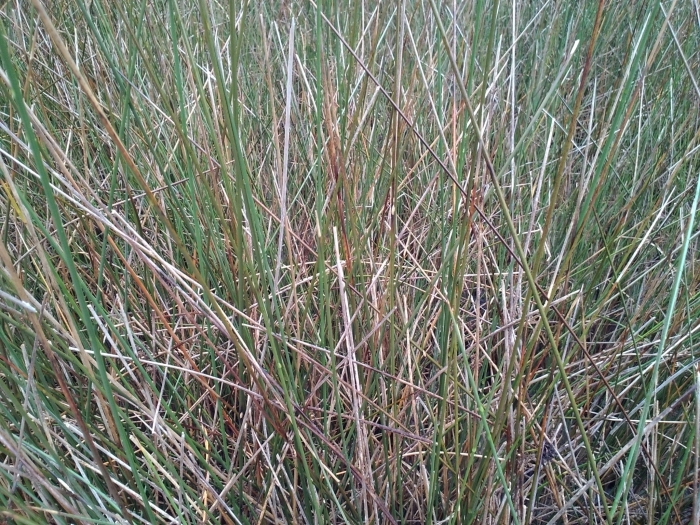Black Needlerush
(Juncus roemerianus)
Black Needlerush (Juncus roemerianus)
/
/

Evan M. Raskin
CC BY 4.0
Image By:
Evan M. Raskin
Recorded By:
Copyright:
CC BY 4.0
Copyright Notice:
Photo by: Evan M. Raskin | License Type: CC BY 4.0 | License URL: http://creativecommons.org/licenses/by/4.0/ | Rights Holder: Evan M. Raskin | Publisher: iNaturalist | Date Created: 2016-05-21T12:53:01Z |



























Estimated Native Range
Summary
Juncus roemerianus, commonly known as Black Needlerush, is an evergreen perennial grass native to coastal salt marshes and brackish wetlands in the Southeastern USA, Bermuda, and the Caribbean. It typically forms dense stands and can vary greatly in size, from less than 30 centimeters (12 inches) to over two meters (6.6 feet) tall, depending on the salinity of the soil. The plant’s gray-green, cylindrical leaves are actually tightly rolled and pointed, giving the appearance of being leafless with sharp-pointed stems. The true stems end in inconspicuous brownish inflorescences that are not particularly showy. Black Needlerush plays a crucial ecological role in its native habitat, providing erosion control and habitat for wildlife.
Black Needlerush is valued for its ability to thrive in challenging wetland environments, making it suitable for water gardens, rain gardens, and restoration projects. It is also used for erosion control along shorelines. In cultivation, it requires full sun exposure and can tolerate a range of water conditions, from standing water to moderately dry soil, as long as the soil is consistently moist. It is adaptable to various soil types but prefers those with medium to slow drainage. While generally low-maintenance, it can be susceptible to rust and leaf spot diseases.CC BY-SA 4.0
Black Needlerush is valued for its ability to thrive in challenging wetland environments, making it suitable for water gardens, rain gardens, and restoration projects. It is also used for erosion control along shorelines. In cultivation, it requires full sun exposure and can tolerate a range of water conditions, from standing water to moderately dry soil, as long as the soil is consistently moist. It is adaptable to various soil types but prefers those with medium to slow drainage. While generally low-maintenance, it can be susceptible to rust and leaf spot diseases.CC BY-SA 4.0
Plant Description
- Plant Type: Grass
- Height: 5-7 feet
- Width: 0.714-1 feet
- Growth Rate: Moderate
- Flower Color: N/A
- Flowering Season: Spring
- Leaf Retention: Evergreen
Growth Requirements
- Sun: Full Sun
- Water: High
- Drainage: Medium, Slow
Common Uses
Bird Garden, Deer Resistant, Low Maintenance, Water Garden
Natural Habitat
Coastal salt marshes and brackish wetlands in the Southeastern USA, Bermuda, and the Caribbean
Other Names
Common Names: Roemer’s Rush, Needle Rush, Needle-Grass Rush, Black Rush, Needlegrass Rush
Scientific Names: , Juncus roemerianus,
GBIF Accepted Name: Juncus roemerianus Scheele